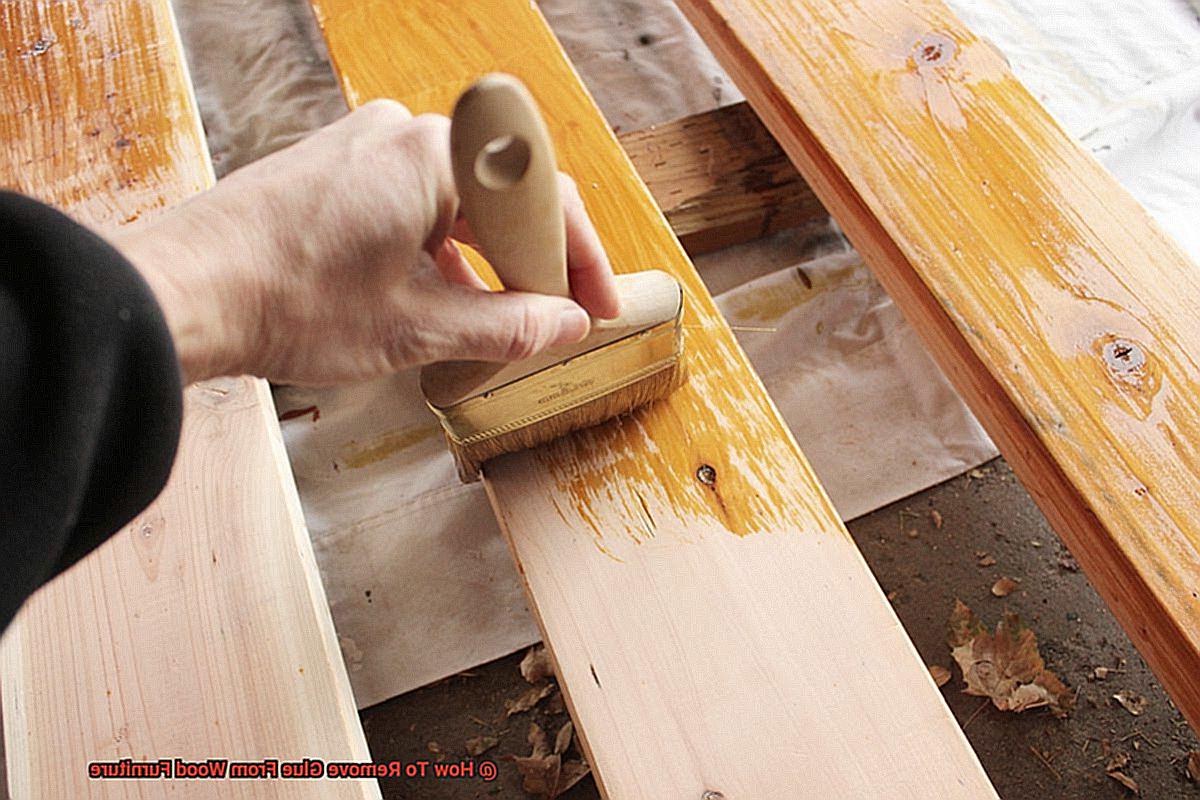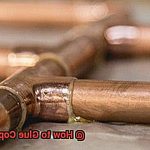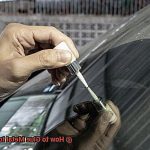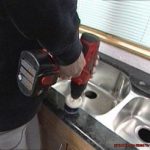Are you struggling to remove glue from your wood furniture? Don’t worry. There are some simple steps you can take to get rid of the sticky residue without damaging your furniture.
I’m here to share my top tips for removing glue from wood furniture and restoring it back to its original condition. Whether it’s a spilled bottle of superglue or an old sticker that’s been on for years, I’ll provide all the details you’ll need.
From natural remedies like vinegar and baking soda, to chemical removers such as acetone and paint thinner – I’ve got it covered. I’ll also explain the different types of glues used on wood furniture so you can identify what needs to be removed.
With these easy steps, you can safely remove glue from wood furniture and keep it looking new for many years to come.
Identifying the Type of Glue Used on the Furniture
Contents
- 1 Identifying the Type of Glue Used on the Furniture
- 2 Non-Abrasive Removal Methods: Using Heat and Vinegar
- 3 Abrasive Removal Methods: Using a Heat Gun or Hairdryer
- 4 Abrasive Removal Methods: Using Solvents Such as Mineral Spirits or Denatured Alcohol
- 5 Testing the Removal Method on an Inconspicuous Area
- 6 Wearing Protective Gear When Using Solvents
- 7 Working in a Well-Ventilated Area When Using Solvents
- 8 Tips for Removing Glue from Wood Furniture
- 9 Conclusion
Removing glue from wood furniture can be a tricky task, but with the right knowledge and patience, you’ll be able to identify the type of glue used and determine the best removal technique.
The four most common types of glue used on wood furniture are polyurethane (aka Gorilla Glue), epoxy, PVA or white glue, and contact cement. Each one has its own unique attributes that can help you determine which one was used.
Polyurethane glue dries to a light tan color and is waterproof, while PVA or white glue is water-based and dries clear. Contact cement is solvent-based and provides an instant bond between two surfaces.
To start, check the manufacturer’s label for any information about the type of glue used. Then examine the area where the glue was applied to identify its color and texture.

Once you have identified which type of glue was used, you can begin by trying non-abrasive techniques such as heat or vinegar to remove it safely without damaging the wood furniture. For tougher glues like contact cement, you’ll need to soften it with a heat gun or hair dryer before scraping it off with a scraper.
Before attempting any removal technique on your furniture, test it out on an inconspicuous area first to ensure that it does not damage it in any way.
Non-Abrasive Removal Methods: Using Heat and Vinegar
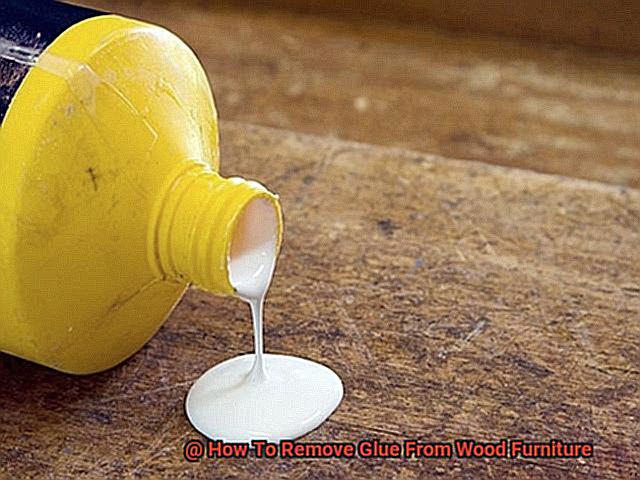
Removing glue from wood furniture can be tricky, but with the right tools and techniques, you can easily tackle the job like a pro.
Heat and vinegar are two popular non-abrasive methods for removing glue from wood, both of which can help soften and loosen the glue without damaging the wood surface. Using heat to remove glue from wood is a straightforward process.
Hold a heat gun or hair dryer near the glue on the wood surface for a few minutes until it softens. Then, use a putty knife or similar tool to scrape off the hardened glue.
Be sure not to overheat as this could cause discoloration or damage to the wood. Vinegar is also an excellent natural solution for removing glue from wooden surfaces due to its acidic properties.
White vinegar is best; pour some onto a cloth and place it on the affected area for a few minutes, allowing it to soak into the glue. To remove the softened glue, use a scraper or putty knife.
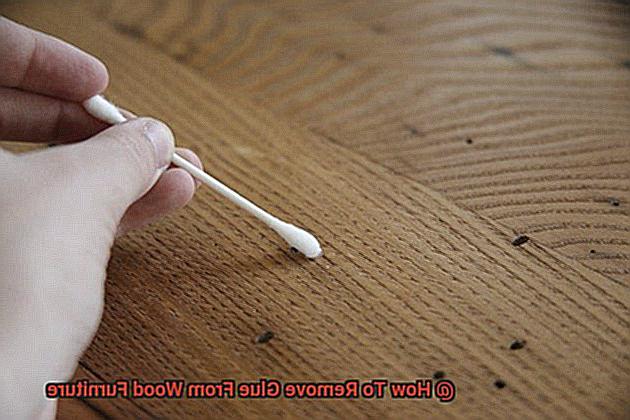
Vinegar is safe and natural, so you may need several attempts before all of the glue is removed.
Abrasive Removal Methods: Using a Heat Gun or Hairdryer
A heat gun or hairdryer can be an effective way to remove glue from wood furniture without causing any damage.
This abrasive removal technique is quick and simple, allowing you to get rid of sticky glue with minimal effort. To start, plug in your device and set it to the highest setting.
Point it at the area with glue that you want to remove, holding it a few inches away from the surface. Keep the heat gun or hairdryer moving continuously so that the heat is evenly distributed.
As the glue softens, use a scraper or putty knife to carefully remove as much of it as possible. Once you’ve scraped away all of the glue, clean the area thoroughly with rubbing alcohol or vinegar.
It’s important to note that this method isn’t suitable for every type of adhesive. For example, if you’re trying to remove super glue or other strong adhesives, this method may not be effective.
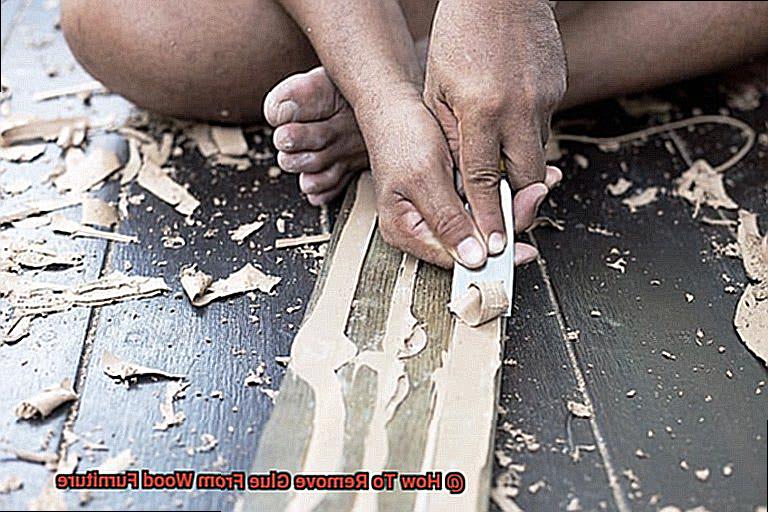
Overall, using a heat gun or hairdryer is an efficient way to safely remove glue from wood furniture without causing harm.
Abrasive Removal Methods: Using Solvents Such as Mineral Spirits or Denatured Alcohol
Don’t worry, as abrasive removal methods using solvents such as mineral spirits or denatured alcohol can help to get rid of it.
These methods are often employed when other techniques have failed, and the glue has hardened and become difficult to remove. However, it is important to note that using abrasive methods can damage the wood’s finish, so caution should be taken.
Begin by applying a small amount of mineral spirits or denatured alcohol to a soft cloth and gently rubbing the affected area. To ensure that the solvent does not cause any harm, test a small, inconspicuous area of the furniture first.
Keep rubbing until the glue has softened and can be wiped away with a second cloth. After removing the glue, cleanse the area with a mild detergent and water, then dry thoroughly.
Before beginning any major cleaning job, always test a small part first and remember to clean thoroughly after removing the glue.
Testing the Removal Method on an Inconspicuous Area
When trying to remove glue from wood furniture, it is imperative to first test the removal method in an inconspicuous area.
This step is essential for protecting the furniture’s finish and ensuring a successful glue removal. By selecting an area on the furniture where the glue stain is not visible or can be easily covered, you can apply the chosen removal method and observe if there is any damage to the furniture’s finish or color.
Testing will also help you determine whether your chosen method is effective in removing the glue. If it proves to be ineffective in this area, then it’s unlikely that it will be useful elsewhere.
If you find that it damages the finish or color, then you may need to try a different approach or seek professional assistance. In summary, testing the removal method on an inconspicuous area is key when trying to remove glue from wood furniture.
It helps determine whether the method is safe for use and effective in removing glue without causing damage to visible areas of your beloved wooden furniture.
Wearing Protective Gear When Using Solvents
When it comes to removing glue from wood furniture, safety should always come first.
To protect yourself from the volatile vapors of solvents, you must don your protective gear like a superhero’s suit of armor. This includes wearing gloves and goggles made of nitrile or neoprene rubber to guard against direct contact with your skin and eyes.
Make sure the goggles cover the entire eye area and are made of plastic for increased protection. In addition to protective gear, it is also important to work in a well-ventilated area.
Open windows and turn on fans to ensure there is adequate airflow in the room. Proper ventilation helps reduce exposure to hazardous fumes while still allowing solvents’ vapors to dissipate quickly.
Make sure you do not smoke or light any flames when using solvents, as most are highly flammable and can cause fires or explosions with just a spark or flame. Additionally, keep solvents away from heat sources such as radiators and hot surfaces.
Working in a Well-Ventilated Area When Using Solvents
When it comes to removing glue from wood furniture, safety should always be your top priority.
To protect yourself from potential harm, make sure you work in a well-ventilated area and wear the necessary protective gear. Think of it like putting on your superhero costume – just as Superman puts on his cape and glasses to shield himself from danger, you should don gloves and goggles made of nitrile or neoprene rubber, as well as a respirator mask to filter out hazardous chemicals in the air.
Additionally, open windows and doors to allow fresh air into the space and use fans to circulate the air around. When selecting a solvent for this project, opt for one with a slower evaporation rate.
Tips for Removing Glue from Wood Furniture
Removing glue from wood furniture can seem like a difficult task, but with the right techniques and equipment, it’s possible to get rid of the residue without damaging the surface. Whether you’ve accidentally spilled glue on your beloved furniture pieces or are trying to restore an old piece of furniture, here are five tips for removing glue from wood furniture.
Start by using a scraper or putty knife to remove as much of the glue as possible without damaging the wood.
To further loosen the glue, try rubbing a cloth dipped in warm water mixed with dish soap over the area. For more stubborn stains, rub a cloth soaked in rubbing alcohol or vinegar onto the stain and let it sit for a few minutes before wiping away with a clean cloth.
Alternatively, apply a paste made of baking soda and water onto the stain and gently rub it off after it has had some time to sit.
If none of these methods work, try using a commercial adhesive remover specifically designed for removing glue from wood furniture. However, make sure to read the instructions carefully and test it on an inconspicuous area first to ensure that it won’t damage the wood surface.
Lastly, if all else fails, use a plastic scraper to gently scrape away any remaining glue residue from your wood furniture – be sure not to use too much pressure or use a metal scraper as this will cause damage to the wood.
7jPr72RmyjM” >
Conclusion
Removing glue from wood furniture can be a daunting task, but with the right knowledge and techniques, it’s possible to restore your beloved furniture to its original condition.
Whether you’re dealing with a spilled bottle of superglue or an old sticker that has been around for years, there are several options available to safely remove the glue without damaging the wood surface. From natural remedies such as vinegar and baking soda to chemical removers such as acetone and paint thinner, you have a variety of solutions at your disposal.
However, it’s important to consider the type of glue used on the furniture before attempting any removal method. When removing glue from wood furniture, always test any method in an inconspicuous location first and wear protective gear when using solvents.
Additionally, make sure you work in a well-ventilated area and keep solvents away from heat sources or open flames as they are highly flammable.

